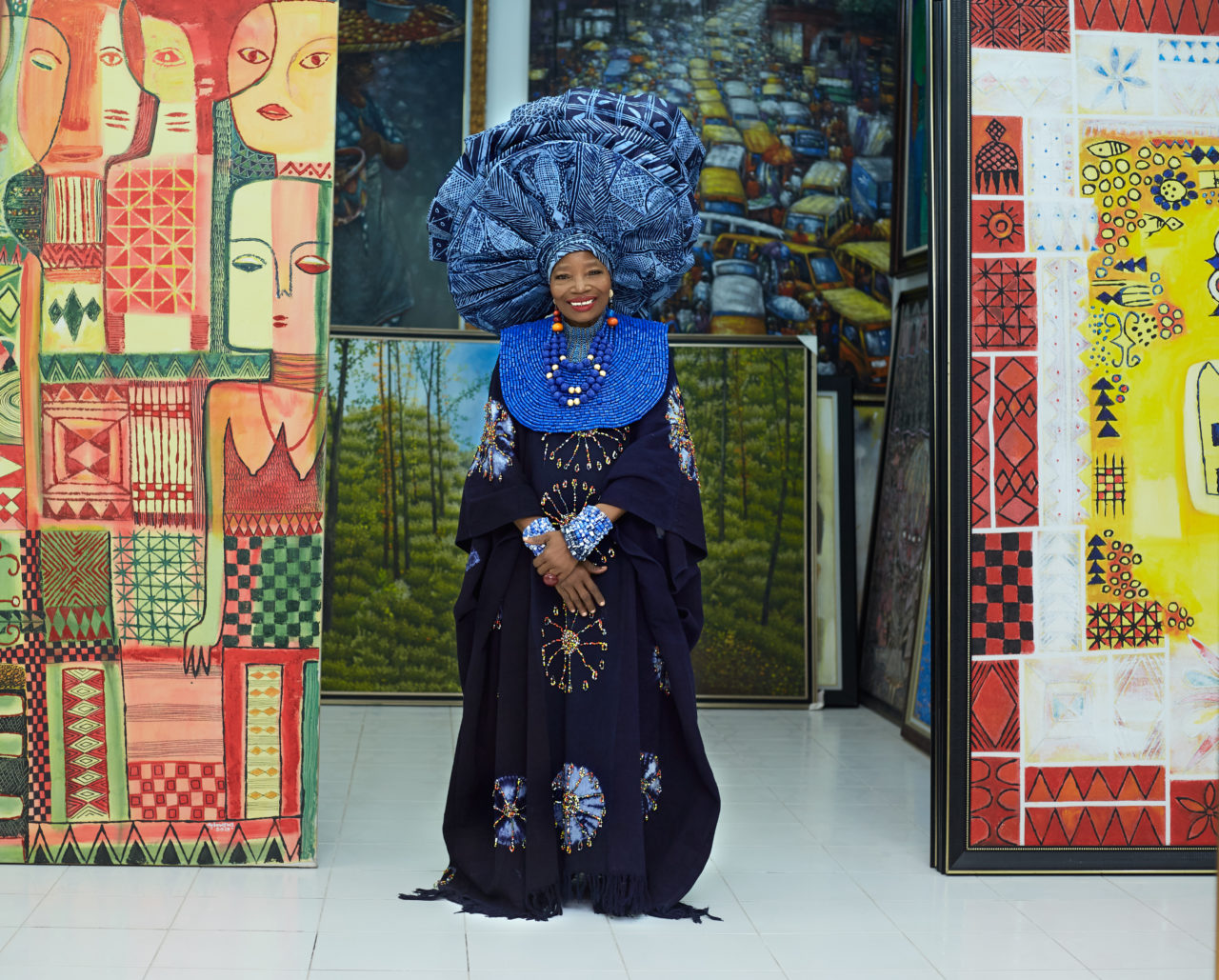Nike Okundaye was born in 1951 in Ogidi, Kogi State, in North-Central Nigeria, and was brought up amidst the traditional weaving and dyeing as practiced in her hometown. Her parents and great-grandmother were musicians and craftspeople, who specialized in the areas of cloth weaving, adire making, indigo dyeing and leather. Nike Davies-Okundaye is a well-reputed artist best known for her cloth work and embroidery pieces. She learned how to use the loom to produce cloth during the time she lived with her great grandmother Ibitola (“Red Woman”).
Read more about Women
She spent part of her early life in Osogbo, Western Nigeria, modern-day Osun State. Osogbo is also recognized as a major center for art and culture in Nigeria. Growing up in Osogbo, Osun state, young Nike was exposed to indigo dyeing and Adire production which dominated her informal training.
Career
Over the past twenty years, she has given workshops on traditional Nigerian textiles to audiences in the United States and Europe. She had her first solo exhibition at the Goethe Institute, Lagos in 1968. She is the founder and director of four art centers that offer free training to over 150 young artists in visual, musical and performing arts, comprising more than 7,000 artworks.
Finding that the traditional methods of weaving and dyeing that had been her original inspiration were fading in Nigeria, Davies-Okundaye set about launching a revival of this aspect of Nigerian culture, building art centers offering free courses for young Nigerians to learn traditional arts and crafts. As art historian John Peffer states,
“One thing shared by many of the latest generations of African artists in the diaspora – those who have been successful on the art circuit – is that their work critiques the very burden of representation that is also the condition of their visibility.”
In her eyes, the traditional art of Adire Eleko is only possible because of a specific Nigerian heritage of passing knowledge from one generation to the next. In a video interview published by Nubia Africa, Okundaye states that “schools can only teach what they [art students] already know.” According to a CNBC Africa interview, she trained more than 3000 young Nigerians for free and she continues to help by funding many poor to establish their small businesses and art workshops in different parts of Nigeria.
Sign up for the Connect Nigeria daily newsletter
Davies-Okundaye’s adire and batik textiles use visual themes taken from Yoruba history and mythology. As well as, visual themes inspired by her own life experiences and dreams. According to Vaz, folklore often inner mingles with personal experiences to express disheartening subjects regarding female suffering. Folklores that Davies-Okundaye was exposed to through evening stories spoken by the village elder, addressing social issues centred around female suffrage. David-Okundaye uses folklore figures to express her concerts on the female suffering through her batiks that portray the Goddess Osun (ie. “Mother of Africa”) communicating on ideologies and social norms that placed females in constrained positions.
Davies-Okundaye strives to improve the lives of disadvantaged women in Nigeria through art. She teaches the unique techniques of indigo cloth-dyeing (Adire) to rural women at her workshop in southwest Nigeria. She hopes to revive the centuries-old tradition and the lives of these women. Adire – that which is tied and dyed – is native to the Southwest region of Nigeria. The freehand dyeing is sometimes known as Adire Eleko. “Adire” refers to indigo dye, and ‘Eleko’ refers to the boiled cassava, lime, and alum resist technique used to create patterns. There is a strong tendency to keep dyeing recipes and methods secret from inquisitive outsiders. Davies-Okundaye chooses to continuously reference Adire patterns in her artwork because Adire is a women’s art, and was taught to her by her mother. Adire pattern motifs were traditionally handed down from mother to daughter, and the designs themselves virtually have not changed in form over time.
Register to attend the Connect Nigeria Business Mixer
Davies-Okundaye was featured on CNN International’s “African Voices” which tells about Africa’s most engaging personalities, exploring their lives and passions. Moreover, Nike’s painting is permanently featured at The Smithsonian Museum as of 2012, and her work is also part of the collection of the Gallery of African Art and The British Library, in London and at Johfrim Art and Design Studio. She holds the chieftaincy titles of the Yeye Oba of Ogidi-Ijumu and the Yeye Tasase of Oshogbo.
Published sources
A book about Nike was written by Kim Marie Vaz, The Woman with the Artistic Brush: A Life History of Yoruba Batik Artist Nike Okundaye.
Honours
In 2019 Rhodes University in Grahamstown announced it would award Davies-Okundaye an honorary doctorate in fine arts (DFA, hc).
Nike Okundaye was included in the 2019 show I Am…Contemporary Women Artists of Africa at the Smithsonian’s National Museum of African Art in Washington, DC.
Chief Nike Davies-Okundaye, also known as Nike Okundaye, Nike Twins Seven Seven and Nike Olaniyi, is a Nigerian batik and Adire textile designer.
Reference
ngnews247.com
wikipedia.org
Featured Image Source: The Guardian Nigeria News
Got a suggestion? Contact us: [email protected]


